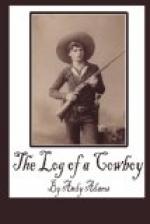“You mean on the Cimarron last year when we mixed two herds,” said Quince, who had taken the bait like a bass and was now fully embarked on a yarn. “We were in rather close quarters, herds ahead and behind us, when one night here came a cow herd like a cyclone and swept right through our camp. We tumbled out of our blankets and ran for our horses, but before we could bridle”—
Bull had given us the wink, and every man in the outfit fell back, and the snoring that checked the storyteller was like a chorus of rip saws running through pine knots. Forrest took in the situation at a glance, and as he arose to leave, looked back and remarked,—
“You must all think that’s smart.”
Before he was out of hearing, Durham said to the rest of us,—
“A few doses like that will cure him of sucking eggs and acting smart, interrupting folks.”
CHAPTER IV
THE ATASCOSA
For the next few days we paralleled the coast, except when forced inland by various arms of the Laguna Madre. When about a week out from the Arroyo Colorado, we encountered the Salt Lagoon, which threw us at least fifty miles in from the coast. Here we had our last view of salt water, and the murmurings of the Gulf were heard no more. Our route now led northward through what were then the two largest ranches in Texas, the “Running W” and Laurel Leaf, which sent more cattle up the trail, bred in their own brand, than any other four ranches in the Lone Star State. We were nearly a week passing through their ranges, and on reaching Santa Gertruda ranch learned that three trail herds, of over three thousand head each, had already started in these two brands, while four more were to follow.
So far we had been having splendid luck in securing water for the herd, once a day at least, and often twice and three times. Our herd was becoming well trail-broken by this time, and for range cattle had quieted down and were docile and easy to handle. Flood’s years of experience on the trail made him a believer in the theory that stampedes were generally due to negligence in not having the herd full of grass and water on reaching the bed ground at night. Barring accidents, which will happen, his view is the correct one, if care has been used for the first few weeks in properly breaking the herd to the trail. But though hunger and thirst are probably responsible for more stampedes than all other causes combined, it is the unexpected which cannot be guarded against. A stampede is the natural result of fear, and at night or in an uncertain light, this timidity might be imparted to an entire herd by a flash of lightning or a peal of thunder, while the stumbling of a night horse, or the scent of some wild animal, would in a moment’s time, from frightening a few head, so infect a herd as to throw them into the wildest panic. Amongst the thousands of herds like ours which were driven over the trail during its brief existence, none ever made the trip without encountering more or less trouble from runs. Frequently a herd became so spoiled in this manner that it grew into a mania with them, so that they would stampede on the slightest provocation,—or no provocation at all.




